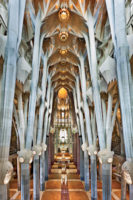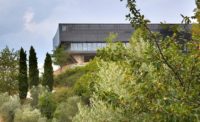Milan, Italy
In the historic center of Milan, two buildings represent opposites in almost every way. The Duomo is the city’s centerpiece, and its confection of flamboyant Gothic and complementary Renaissance-style cupolas, spires, and flying buttresses stoke the spirit. Overlooking its north-facing transept is La Rinascente, the famous eight-story department store that attracts shoppers offering devotions to Cavalli, Etro, and other fashion brands. The 58-year-old building—with its stout colonnade and largely opaque, symmetrical facades—expresses foreboding in contrast to the Duomo’s sugary exuberance.
In the historic center of Milan, two buildings represent opposites in almost every way. The Duomo is the city’s centerpiece, and its confection of flamboyant Gothic and complementary Renaissance-style cupolas, spires, and flying buttresses stoke the spirit. Overlooking its north-facing transept is La Rinascente, the famous eight-story department store that attracts shoppers offering devotions to Cavalli, Etro, and other fashion brands. The 58-year-old building—with its stout colonnade and largely opaque, symmetrical facades—expresses foreboding in contrast to the Duomo’s sugary exuberance.
Last year, Lifschutz Davidson Sandilands (LDS) translated some of the Duomo’s delight to the interior of the modern-day temple to shopping. The London-based architects completed an overhaul of La Rinascente’s top floor, which now houses a food hall and a series of restaurant tenants. The highlight of the project is a decorative ceiling in which 508 triangular acrylic modules hover above shoppers like the faceted planes of a giant amber gem or the patches of a Brobdingnagian quilt.
LDS project architect Germano Di Chello says that previously, the eighth floor was a poorly illuminated warren where two restaurants, a bank, a cellphone store, and a beauty salon uneasily sat alongside one another, and back-of-house circulation gobbled a large portion of the 20,000 square feet available. The design team decided, first, to reprogram the space to highlight food solely, and then to change the circulation of the space to maximize selling area. Today, restaurants and cafés surround a central hall where merchandising fixtures hold dry foodstuffs. The overall plan of the floor appears as a trapezium in which one short side faces the Duomo.
The ceiling feature underscores the new pattern. In plan, it spreads out like a large T whose stem runs parallel to the long sides of the trapezium; the arms of the T hug the front of the building, where diners overlook the roofline of the renowned cathedral. Di Chello says this form allows shoppers to understand the new circulation, and to orient themselves to the Duomo.
The trapezium plan also drove the design of the ceiling modules with LDS halving that shape into pairs of isosceles triangles. “We initially thought of it as a flat quilt, but then we decided to play with an undulating three-dimensional quality by lowering one of the corners below the others to create depth,” Di Chello explains. As a result, there are four kinds of acrylic units. Two are isosceles triangles in which a different corner tapers in height, a third module emphasizes the vertex of the isosceles triangle so that it resembles a prow, and a fourth is tailored to accommodate existing ventilation.
A subcontractor, Camagni Arredamenti, laser cut and glued the acrylic planes into the quiltlike modules. Di Chello also explains that, as the panels came to evoke honeycomb modules instead of quilt panels, the design team chose the custom amber color to amplify the beehive comparison. The modules are placed on the ceiling randomly, “with no two types touching each other. It could have been one continuous quilt going up and down to create a Yokohama Terminal [RECORD, November 2002, page 142]–type of effect, but we went in this direction instead.”
The modules were installed in a series of aluminum extrusions suspended in rows from the existing concrete ceiling. The extrusions contain upper and lower channels. The lower channel holds a track for metal-halide downlights. Upper slots contain T5 fluorescents that illuminate the white-painted ceiling and reflect back down into the amber acrylic modules. Some extrusions do not include lamps; instead, the channels are left open to pull cool air inside the ceiling feature.
LDS has developed an expertise in department-store penthouses. Prior to the La Rinascente job, it created top-floor restaurants and food halls for new Harvey Nichols stores in Edinburgh and Manchester, for example. “We always opted for a solution that included the ceiling,” Di Chello says, comparing the feature to a “vertical bookend” that makes shoppers realize they’ve reached the top floor. In those earlier projects, LDS used coffers mounted with cold-cathode lighting, whereas at La Rinascente the ceiling is embossed and illuminated from within. This latest manifestation of the vertical bookend may be a variation on a theme, but in the case of La Rinascente’s amber accent, LDS injected dynamism into an intimidating building—and reminded shoppers that Milan’s original destination is right next door.




